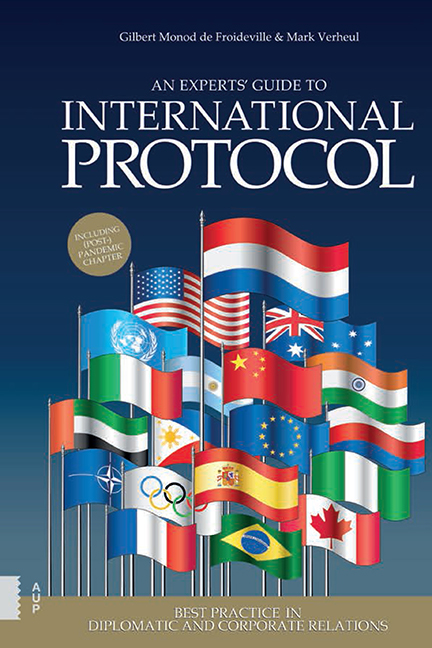Book contents
- Frontmatter
- Contents
- Preface to the original edition by His Royal Highness Prince Carlos de Bourbon de Parme
- Prologue
- Acknowledgements
- 1 International Protocol
- 2 Precedence
- 3 Seating Arrangements and Order of Processions
- 4 Flag Protocol
- 5 Invitations and Dress Codes
- 6 Gifts and Honours
- 7 Ceremonies
- 8 The Protocol Officer
- 9 Guest and Host
- 10 Protocol and Stakeholder Engagement During and after the COVID-19 Pandemic
- Authors’ Biographies
- Bibliography
- Websites
- Illustrations and Photographs
- Index
1 - International Protocol
Published online by Cambridge University Press: 27 May 2021
- Frontmatter
- Contents
- Preface to the original edition by His Royal Highness Prince Carlos de Bourbon de Parme
- Prologue
- Acknowledgements
- 1 International Protocol
- 2 Precedence
- 3 Seating Arrangements and Order of Processions
- 4 Flag Protocol
- 5 Invitations and Dress Codes
- 6 Gifts and Honours
- 7 Ceremonies
- 8 The Protocol Officer
- 9 Guest and Host
- 10 Protocol and Stakeholder Engagement During and after the COVID-19 Pandemic
- Authors’ Biographies
- Bibliography
- Websites
- Illustrations and Photographs
- Index
Summary
Introduction
Why write a book on international protocol at a time when people often speak negatively about protocol, etiquette, and codes of conduct? The writers of this book are very aware of these tendencies but hope that this book will clarify the use of protocol, its development, and the particularities of the role it plays in the international world, where it reveals a respect for the traditions and cultures of others.
Protocol is no longer just the catch-all term for the written and unwritten rules of diplomatic and social discourse between heads of state, heads of government, and authorities as laid out by the Treaties of Vienna (1814–1815 and 1961–1963). Today international protocol concerns itself as well with conduct between industrial partners and the cultural and sport sector.
Conduct is not only based on existing international practices and rules of respect, but also with the goal of accurately profiling countries, organisations and businesses, securing important business contracts, and meeting the right people. It can therefore be said that protocol is a tool for maintaining good relationships.
The application of international protocol focuses on three aspects. First, it is intended to minimise tedious discussions on who must sit where, in what order and in what manner flags are displayed, or in what order people must walk, stand, or greet guests. Second, it is a means of avoiding unnecessarily disturbing diplomatic relations, and third, it is intended to cultivate a climate in which everyone feels comfortable and which lends itself well to positive decision-making.
In short, we can say that protocol is the catch-all term for establishing proper conduct in order to avoid conflicts and arguments. However, maintaining functionality always prevails over carrying out the correct protocol. Nonetheless, protocol is often confused with etiquette, and it is necessary to outline the differences between the two.
Protocol vs Etiquette
What is the essential difference between protocol and etiquette? Etiquette can be defined as the rules of politeness between people, i.e. social manners. This would include examples like opening doors for people, proper ways of greeting, pulling a chair out for a woman, and so on, while protocol tends to focus much more on the status of a person, a country, an organisation, or a business rather than societal status.
- Type
- Chapter
- Information
- An Experts' Guide to International ProtocolBest Practices in Diplomatic and Corporate Relations, pp. 17 - 40Publisher: Amsterdam University PressPrint publication year: 2021



